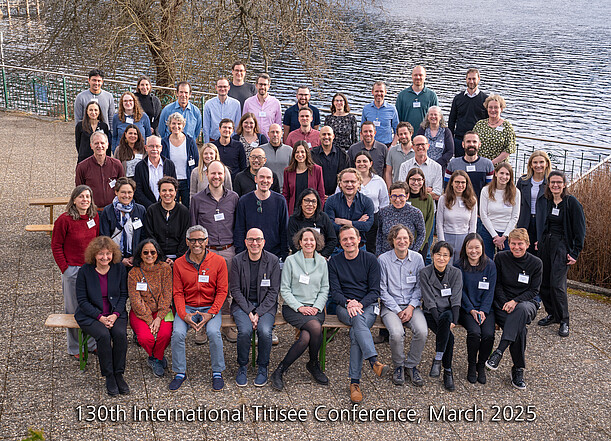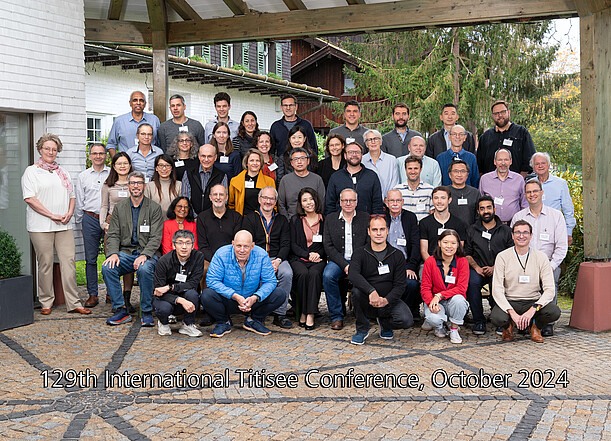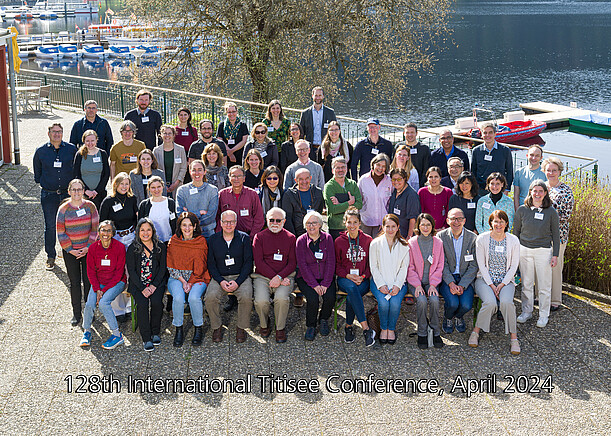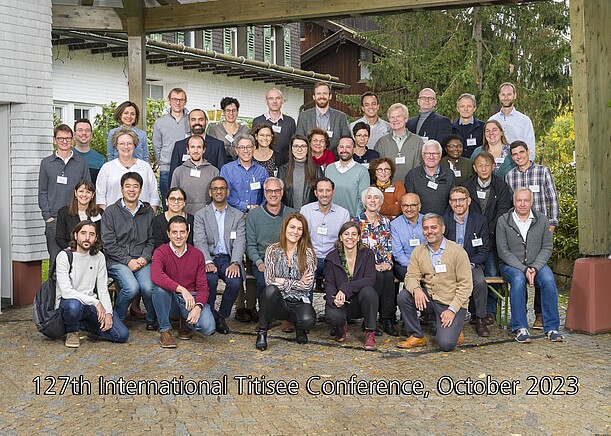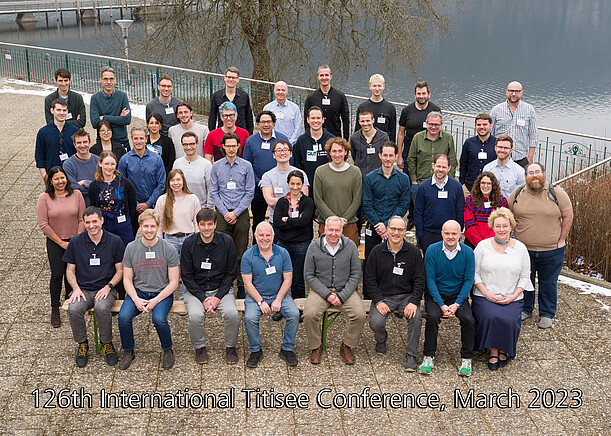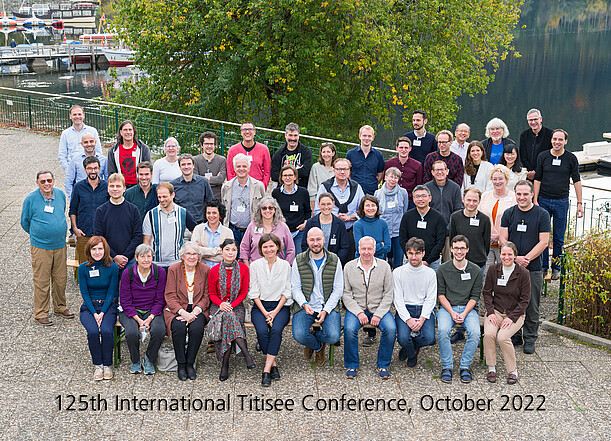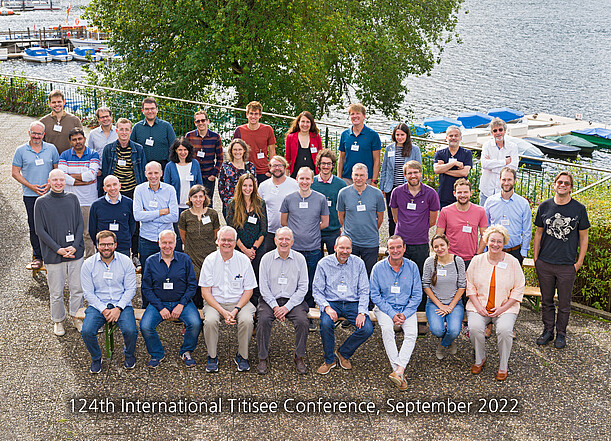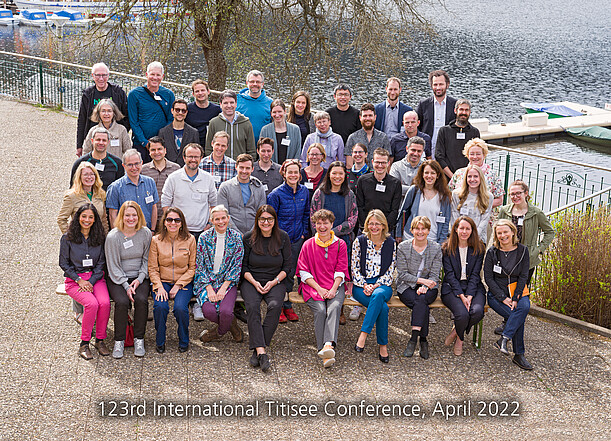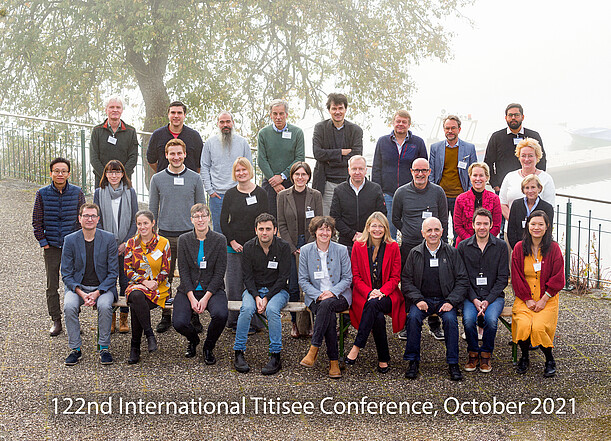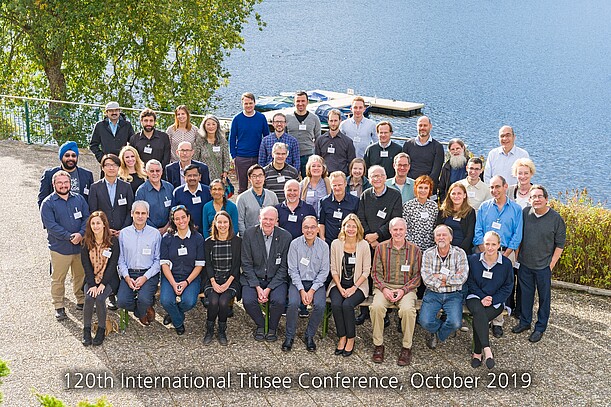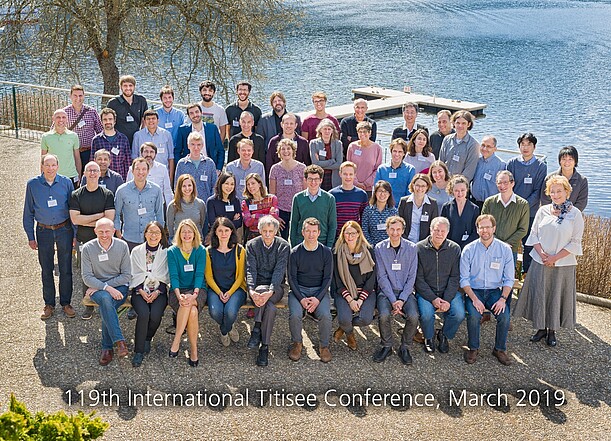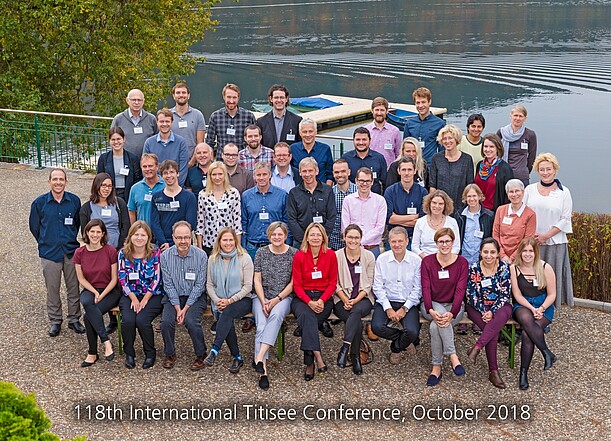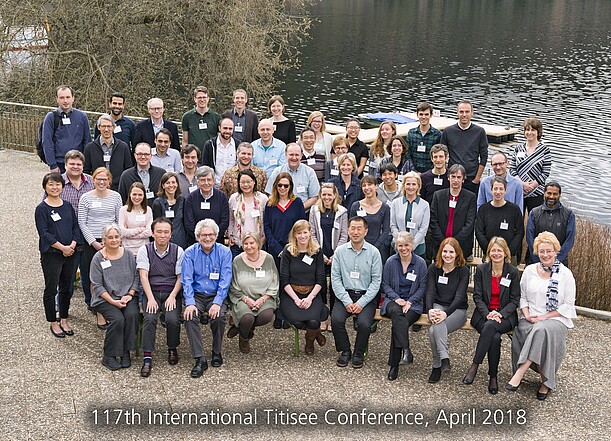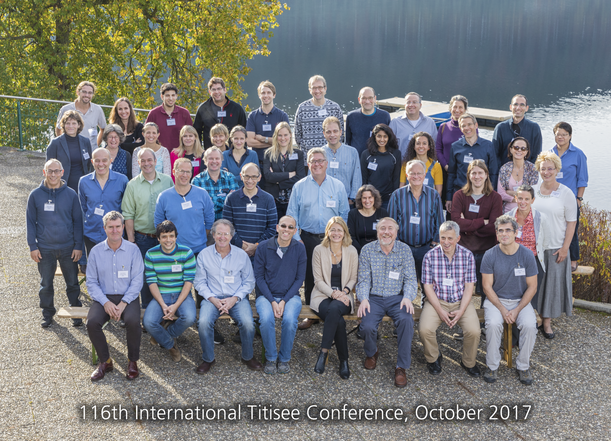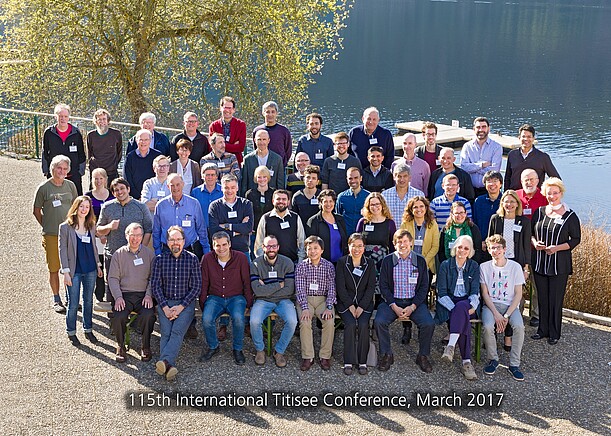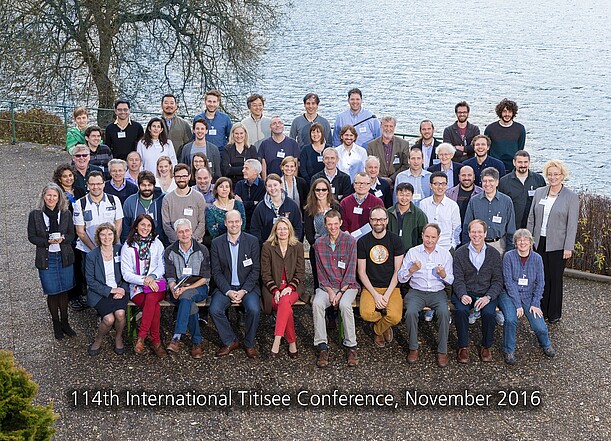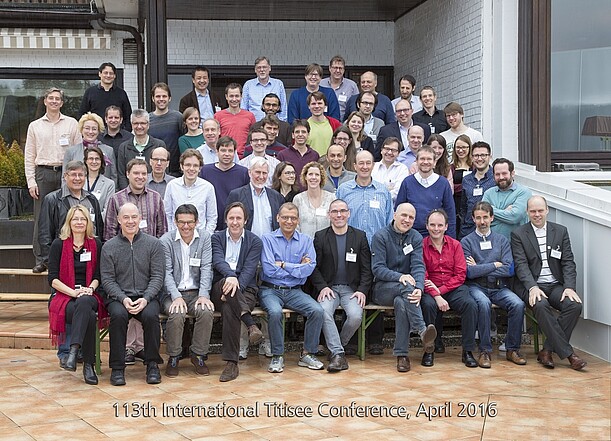Past conferences
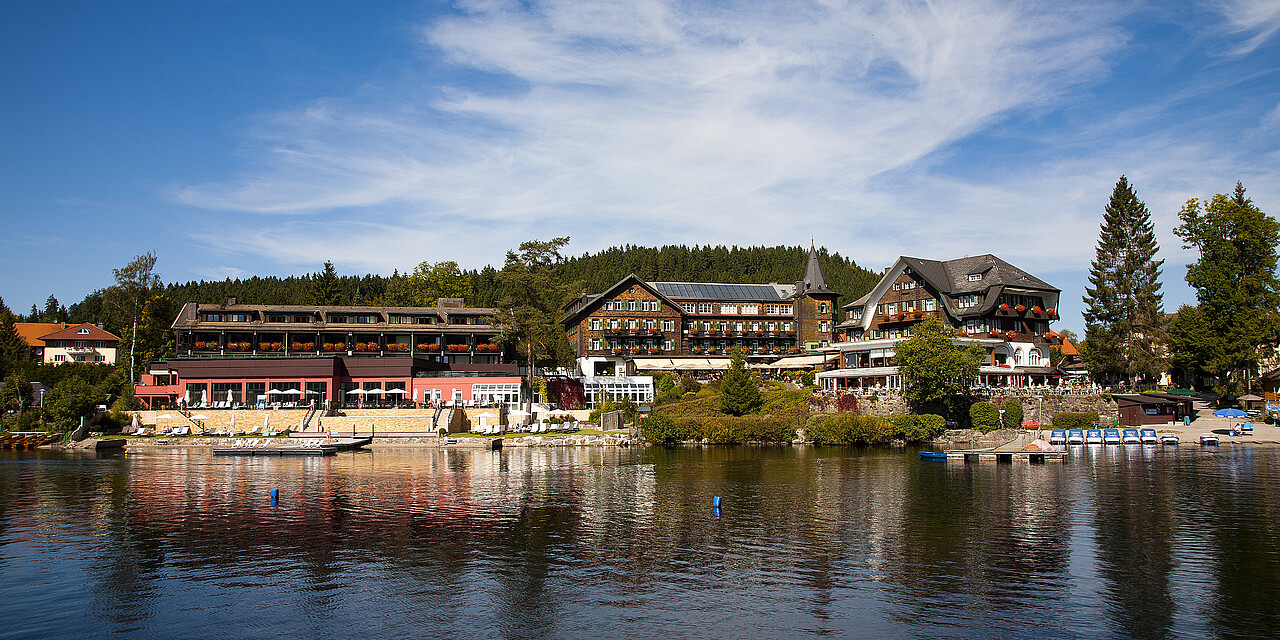
What were past ITC topics?
From the very first conference in 1962, the International Titisee Conferences (ITCs) were meant to offer a unique experience for the participating scientists. The idea was to create an inviting, retreat-like setting as well as an atmosphere that would stimulate scientific exchange between researchers and between subdisciplines. Until 1983, the ITCs were organized by the Company Dr Karl Thomae GmbH, a subsidiary of Boehringer Ingelheim company. From then on, the newly founded non-profit foundation Boehringer Ingelheim Fonds (BIF) took over their organization and the focus shifted from medicine to basic research in biomedical science. Their concept, however, has changed little over time, and the ITCs have gained an excellent reputation among scientists.
Chaired by Jan-Erik Siemens, Heidelberg, Germany and James Poulet, Berlin, Germany
Temperature profoundly affects every aspect of life, from enzymatic reactions to physiological processes and behaviour. Brief hot or cold changes in temperature can evoke powerful sensations ranging from pleasurable warmth, to aversive cold, and imprint long lasting memories. Long-term changes in environmental temperature require adaptation among all species, prompting adjustments in behaviour and core physiological parameters in order to survive. The thermal environment thereby acts as a regulator of functions essential for survival, including our metabolism, circadian rhythms, cardiac function, and behaviour. However, a holistic understanding of the link between thermal sensation, thermal adaption/acclimation, and core physiology – systems thermobiology – is missing.
This conference attempts to bridge this fundamental knowledge gap and aims to bring together scientists who study different levels and aspects of temperature – and in particular how temperature interacts with the nervous system – in humans and model organisms. Due to seminars and discussions on core body temperature, energy metabolism, sensation, plasticity, adaptation (acclimation), and behaviour, we believe that this ITC will foster new concepts and research directions that address the complex and diverse functions of biological thermal systems.
Invited Speakers:
- Ackerley, Rochelle (Marseille, France)
- Barth, Alison L. (Pittsburgh, PA, USA)
- Cannon, Barbara (Stockholm, Sweden)
- Carcea, Ioana (Newark, NJ, USA)
- Chen, Xiaoke (Stanford, CA, USA)
- Fenselau, Henning (Cologne, Germany)
- Filingeri, Davide (Southampton, United Kingdom)
- Gallio, Marco (Evanston, IL, USA)
- Garrity, Paul (Waltham, MA, USA)
- Gracheva, Elena (New Haven, CT, USA)
- Haesemeyer, Martin (Columbus, OH, USA)
- Haggard, Patrick (London, United Kingdom)
- Hrvatin, Siniša (Cambridge, MA, USA)
- Kim, Sung-Yon (Seoul, South Korea)
- Julius, David (San Francisco, CA, USA)
- Lemon, Christian H. (Norman, OK, USA)
- Lewin, Gary R. (Berlin, Germany)
- Machado, Natalia (Boston, MA, USA)
- Marder, Eva (Waltham, MA, USA)
- Matarazzo, Valéry (Marseille, France)
- Ryan, Tomás (Dublin, Ireland)
- Schreiber, Susanne (Berlin, Germany)
- Seebacher, Frank (Sydney, NSW, Australia)
- Shen, Wei (Shanghei, China)
- Tattersall, Glenn J. (St. Catharines, ON, Canada)
- Tupone, Domenico (Bologna, Italy)
- Vestergaard, Mikkel (Berlin, Germany)
- De La Iglesia, Felix Viana (Santiago de Compostella, Spain)
- Vincis, Roberto (Tallahassee, FL, USA)
- Voets, Thomas (Leuven, Belgium)
- von Breukelen, Frank (Las Vegas, NV, USA)
- Wang, Hong (Nanshan, Shenzhen, China)
- Whitmire, Clarissa (St. Lucia, QLD, Australia)
- Wisden, William (London, United Kingdom)
- Wittbrodt, Jochen (Heidelberg, Germany)
- Zampieri, Niccolò (Berlin, Germany)
Chaired by Michael Rapé, Berkeley, CA, USA and Brenda A. Schulman, Martinsried, Germany
This meeting will highlight the interdisciplinary science that is driving the discovery, mechanistic dissection, and therapeutic targeting of stress response pathways. These protective systems are required for the 37 trillion cells of our bodies to be produced and preserved at the right time and place despite challenges caused by genetic mutations, environmental toxins, or nutrient limitations. By dissecting the function and regulation of stress response pathways, we stand to learn about fundamental principles of cell fate specification, tissue organization, and organismal homeostasis. By translating such basic understanding into novel therapeutic modalities, we are bound to help many patients afflicted by currently untreatable diseases.
This conference will bring together researchers that dissect stress response signalling at all scales – from atomic resolution to human patients. It will connect scientists who use innovative platforms to discover new signalling pathways with those that alter their output for therapeutic benefit in new cellular and animal models. It will foster discussions between groups providing atomic resolution of large stress signalling complexes and those that invent new chemical or biological approaches to modulate the activity of these signalling machines in disease. Although all these areas of science have seen major breakthroughs in the past years, they have mostly worked apart from each other. We strongly believe that now is the time to introduce them to each other to lay the foundation for collaborations that deepen our understanding of stress signalling pathways from single molecules to complex organisms.
Invited Speakers:
- Bertolotti, Anne (Cambridge, United Kingdom)
- Brar, Gloria (Berkeley, CA, USA)
- Corn, Jacob (Zurich, Switzerland)
- Deshaies, Raymond J. (Pasadena, CA, USA)
- Dikic, Ivan (Frankfurt a.M., Germany)
- Duss, Olivier (Heidelberg, Germany)
- Ferguson, Fleur M. (La Jolla, CA, USA)
- Gur, Dvir (Rehovot, Israel)
- Haakonsen, Diane (Berkeley, CA, USA)
- Harbauer, Angelika (Martinsried, Germany)
- Hartl, F.-Ulrich (Martinsried, Germany)
- Hayer-Hartl, Manajit (Martinsried, Germany)
- Hegde, Ramanujan S. (Cambridge, United Kingdom)
- Hur, Sun (Boston, MA, USA)
- Kampmann, Martin (San Francisco, CA, USA)
- Karagöz, Gülsün Elif (Vienna, Austria)
- Lima, Christopher D. (New York, NY, USA)
- Mann, Matthias (Martinsried, Germany)
- Mayor-Ruiz, Cristina (Barcelona, Spain)
- Münch, Christian (Frankfurt a.M., Germany)
- Nedialkova, Danny (Martinsried, Germany)
- Nomura, Daniel K. (Berkeley, CA, USA)
- Pauli, Andrea (Vienna, Austria)
- Plaschka, Clemens (Vienna, Austria)
- Pleiner, Tino (Stanford, CA, USA)
- Ruggieri, Alessia (Heidelberg, Germany)
- Rutter, Jared P. (Salt Lake City, UT, USA)
- Schaefer, Anne (Cologne, Germany)
- Shao, Sichen (Boston, MA, USA)
- Shiber, Ayala (Haifa, Israel)
- Simonsen, Anne Gjoen (Oslo, Norway)
- Thomä, Nicolas (Lausann, Switzerland)
- Weissman, Jonathan S. (Cambridge, MA, USA)
- Werner, Achim (College Park, MD, USA)
- Wernig, Marius (Stanford, CA, USA)
- Wilfling, Florian (Frankfurt a.M., Germany)
Chaired by Anthony Hyman, Dresden, Germany and Donald Hilvert, Zurich, Switzerland
Understanding the regulation and robustness of metabolic systems is a major challenge in biology. This meeting aims to bring together experts in biomolecular condensates and enzymatic systems to discuss how condensates might influence metabolic regulation and robustness.
While the importance of compartmentalization in metabolism is well-established, it has traditionally been associated with membrane-bound compartments. However, recent discoveries have revealed that many compartments are organized as membraneless condensates. This has redirected attention towards the influence of local enzyme and metabolite concentrations on biochemical reactions. The physical principles of phase separation, reaction diffusion systems, energy consumption, and metabolite fluxes within compartments are being investigated to elucidate their impact on biochemistry.
In the 1920s, Oparin and Haldane proposed that life originated in coacervates, physically separated chemical reactions in the primordial soup. In the 1970s, biochemists recognized the need for higher-order structures to regulate multi-enzyme pathways and proposed the concept of "metabolons." The recent discovery of enzymatic compartments organized by phase separation has renewed interest in the concept of enzyme co-localization. These reversible, flexible, and adaptable condensates may represent the physical manifestation of metabolons proposed earlier, suggesting the preservation of early principles in the organization of cellular biochemistry in present-day organisms.
Invited Speakers:
Alberti, Simon (Dresden, Germany)
Arosio, Paolo (Zurich, Switzerland)
Brangwynne, Clifford P. (Princeton, NJ, USA)
Colón-Ramos, Daniel (New Haven, CT, USA)
Dai, Yifan (St. Louis, MO, USA)
Elsässer, Franziska (Zurich, Switzerland)
Erb, Tobias J. (Marburg, Germany)
Flitsch, Sabine L. (Manchester, United Kingdom)
Hayer-Hartl, Manajit (Martinsried, Germany)
Jain, Ankur (Cambridge, MA, USA)
Johnson, Kenneth A. (Austin, TX, USA)
Jülicher, Frank M. (Dresden, Germany)
Kim, John K. (Baltimore, MD, USA)
Knowles, Tuomas (Cambridge, United Kingdom)
Kollman, Justin (Seattle, WA, USA)
Kyoung, Minjoung (Baltimore, MD, USA)
Lemke, Edward A. (Mainz, Germany)
Lin, Yi (Beijing, China)
Mahamid, Julia (Heidelberg, Germany)
Moran, Joseph (Ottawa, ON, Canada)
Nanda, Piyush (St. Louis, MO, USA)
Pappu, Rohit V. (St. Louis, MO, USA)
Pedley, Anthony (Iowa City, IA, USA)
Phillips, Rob. B. (Pasadena, CA, USA)
Preiner, Martina (Marburg, Germany)
Racki, Lisa (La Jolla, CA, USA)
Rodenfels, Jonathan (Dresden, Germany)
Sartori, Pablo (Oeiras, Portugal)
Schmidt-Dannert, Claudia (St. Paul, MN, USA)
Spruijt, Evan (Nijmegen, The Netherlands)
Tang, Dora (Saarbrücken, Germany)
Webb, Bradley A. (Morgantown, WV, USA)
Wingreen, Ned S. (Princeton, NJ, USA)
Zhang, Jin (La Jolla, CA, USA)
Chaired by Maja Schuldiner, Rehovot, Israel and Blanche Schwappach-Pignataro, Hamburg, Germany
One of the hallmarks of eukaryotic cells are their membrane-bound organelles that create biochemically distinct environments within the cellular milieu. Organelles enable a diversification of functions that is extremely beneficial to the cell. However, it also creates the cell’s most severe problem – how to ensure successful communication between membrane-bound entities to coordinate cellular function.
The 2024 Titisee spring-meeting will showcase the varied ways in which organelles communicate and coordinate – through contact sites, signalling cascades, and vesicular trafficking pathways. We will also focus on how these means of communication are hijacked during infection and on the cellular consequences of their breakdown during ageing and disease progression. Our overarching goal is to bring together experts from multiple disciplines that usually do not meet to uncover fundamental principles of intracellular organization and communication.
Speakers
- Antonny, Bruno (Valbonne, France)
- Bayer, Emmanuelle (Bordeaux, France)
- Bohnert, Maria (Münster, Germany)
- Broichhagen, Johannes (Berlin, Germany)
- Carvalho, Pedro (Oxford, United Kingdom)
- Chacinska, Agnieszka (Warsaw, Poland)
- Costello, Joseph (Exeter, United Kingdom)
- Cruz-Zaragoza, Luis Daniel (Göttingen, Germany)
- Firat Karalar, Elif Nur (Istanbul, Turkey)
- Forrester, Alison (Namur, Belgium)
- Frickel, Eva-Maria (Birmingham, UK)
- Gonzalez Montoro, Ayelen (Osnabrück, Germany)
- Griffiths, Gillian M. (Cambridge, UK)
- Hariri, Hanaa (Detroit, MI, USA)
- Hermann, Johannes (Kaiserslautern Germany)
- Jabs, Sabrina (Kiel, Germany)
- Kim, Peter K. (Toronto, ON, Canada)
- Klemm, Robin W. (Oxford, United Kingdom)
- Kukulski, Wanda (Bern, Switzerland)
- Laufman, Orly (Rehovot, Israel)
- McDowell, Melanie (Frankfurt/Main, Germany)
- Misgeld, Thomas (Munich, Germany)
- Nuebel, Esther ( Salt Lake City, UT, USA)
- Padinjat, Raghu (Bangalore, India)
- Pernas, Lena (Los Angeles, CA, USA)
- Ramakrishnan, Lalita (Cambridge, United Kingdom)
- Rapaport, Doron (Tübingen, Germany)
- Reggiori, Fulvio Mario (Aarhus, Denmark)
- Rehling, Peter (Göttingen, Germany)
- Sheiner, Liach (Glasgow, United Kingdom)
- Shpilka, Tomer (Worchester, MA, USA)
- Sigismund, Sara (Milano, Italy)
- Spang, Anne (Basel, Switzerland)
- Stenmark, Harald (Oslo, Norway)
- Walter, Peter (San Francisco, CA, USA)
- Wang, Meng (Ashburn, VA, USA)
- Winklhofer, Konstanze F. (Bochum, Germany)
Chaired by Benjamin L. Ebert (Boston, MA, USA) and Peter Campbell (Hinxton, Cambridgeshire, UK)
Somatic mutations accumulate in all cells as we age – these mutations begin to accumulate from the moment of conception and continue steadily throughout life in all tissues, even post-mitotic cells. There is cell-to-cell, organ-to-organ, person-to-person, and country-to-country variation in mutation rates and signatures, with much of this variability remaining unexplained. By the time we reach 70 years of age, our bodies will carry in the order of 100 quadrillion somatic mutations, generating huge clonal diversity among cells, providing the substrate for selective processes to enhance or suppress the growth of individual somatic clones.
The meeting will cover the characterization of somatic mutations in healthy and diseased tissues, across many organ systems, spanning the age range from foetal development to the elderly. We will consider the roles that somatic mutations play in the earliest stages of cancer evolution, the functional decline associated with advancing age, and the pathogenesis of diseases other than cancer. We will explore how somatic mutations and selective landscapes could be manipulated, initially in experimental models but ultimately in vivo in humans, to modify the pace of ageing and cancer development.
Invited Speakers:
- Beck, David B. (New York, NY, USA)
- Cabezas-Wallscheid, Nina (Freiburg, Germany)
- Cheek, David (Boston, MA, USA)
- Cvejic, Ana (Cambridge, UK)
- Dick, John (Toronto, ON, Canada)
- Ernst, Aurélie (Heidelberg, Germany)
- Fernandez-Antoran, David (Cambridge, UK)
- Garaycoechea, Juan I. (Utrecht, The Netherlands)
- Gleeson, Joe (La Jolla, CA, USA)
- Goodell, Margaret (Houston, TX, USA)
- Graham, Trevor (London, UK)
- Grayson, Peter (Bethesda, MD, USA)
- Herms, Albert (Barcelona, Spain)
- Izzo, Franco ( New York, NY, USA)
- Jaiswal, Siddhartha (Stanford, CA, USA)
- Janes, Sam (London, UK)
- Ju, Young Seok (Daejon, Korea)
- Knappskog, Stian (Bergen, Norway)
- Kregar, Lori D. (Cambridge, UK)
- López-Bigas, Núria (Barcelona, Spain)
- Manz, Markus (Zurich, Switzerland)
- Martincorena, Inigo (Cambridgehire, UK)
- Maslov, Alex (Bronx, NY, USA)
- Niemeyer, Charlotte (Freiburg, Germany)
- Ogawa, Seishi (Kyoto, Japan)
- Ólafsson, Sigurgeir (Reykjavik, Island)
- Patel, Ketan J. (Oxford, UK)
- Poetsch, Anna (Dresden, Germany)
- Rahbari, Raheleh (Cambridgehire, UK)
- Sanders, Mathijs (Rotterdam, The Netherlands)
- Sankaran, Vijay (Boston, MA, USA)
- Walsh, Christopher (Boston, MA, USA)
- Weeks, Lachelle Dawn (Boston, MA, USA)
- Zucman-Rossi, Jessica (Paris, France)
Chaired by Caswell Barry (London, United Kingdom) and Matthew Botvinick (London, United Kingdom)
The last decade has seen phenomenal advances in the field of machine learning (e.g. deep learning, RL) and its application in AI. While these changes have already had considerable impact on most areas of science, they hold a special resonance for neuroscience. Not only does AI share a common lineage with neuroscience but there is the exciting prospect that machine learning and the brain may employ similar computations to process information. For these reasons machine learning provides a means to emulate neural functions and the circuits supporting them, providing insights and hypotheses to drive our understanding of perception, behaviour, and cognition. Equally, AI tools provide a means to discover, segment, and track distinct neural and behavioural states – yielding more efficient experiments and accelerating the pace of discovery. At the same time, this understanding of the brain’s incredible efficiency and flexibility feeds back into the design of more effective AI approaches, architectures and models.
This link between neuroscience and AI highlights the critical need for a dialogue between individuals whose research spans these two fields – who can pose and test hypotheses about the brain but are also able to apply the lessons learnt to generate further advances in machine learning. This conference, featuring the leaders in the field, will provide an ideal relaxed and informal setting for this dialogue to flourish.
Invited speakers
- Agüera y Arcas, Blaise (Seattle, WA, USA)
- Bakermans, Jacob J.W. (Oxford, United Kingdom)
- Behbahani, Feryal (London, United Kingdom)
- Bethge, Matthias (Tübingen, Germany)
- Binz, Marcel (Tübingen, Germany)
- Boureau, Y-Lan (New York, NY, USA)
- Clopath, Claudia (London, United Kingdom)
- Daw, Nathaniel (London, United Kingdom)
- Dayan, Peter (Tübingen, Germany)
- DiCarlo, James (Cambridge, MA, USA)
- Dobs, Katharina (Gießen, Germany)
- Doeller, Christian (Leipzig, Germany)
- Eckstein, Maria K. (London, UK)
- Faisal, A. Aldo (London, UK)
- Fiete, Ila (Cambridge, MA, USA)
- Gershman, Samuel (Cambridge, MA, USA)
- Huys, Quentin (London, United Kingdom)
- Körding, Konrad P. (Philadelphia, PA, USA)
- Kriegeskorte, Nikolaus (New York, NY, USA)
- Lampinen, Andrew K. (London, United Kingdom)
- Milford, Michael (Brisbane, QLD, Australia)
- Pouget, Alexandre (Geneva, Switzerland)
- Saxe, Andrew (London, United Kingdom)
- Schrimpf, Martin (Lausanne, Switzerland)
- Stachenfeld, Kimberley (London, United Kingdom)
- Summerfield, Christopher (Oxford, United Kingdom)
- Sun, Chen (Montréal, QC, Canada)
- van Gerven, Marcel (Nijmegen, The Netherlands)
- Wang, Jane X. (London, United Kingdom)
- Whittington, James C.R. (Oxford, United Kingdom)
- Yamins, Dan (Stanford, CA, USA)
- Zylbertal, Asaph (London, UK)
Chaired by Leonid A. Mirny (Cambridge, MA, USA) and Job Dekker (Worcester, MA,USA)
Cells organize their genomes in three-dimensional space to facilitate and regulate a wide array of chromosomal functions ranging from gene regulation and DNA replication to chromosome condensation and segregation during cell division. During the last decade we have witnessed a revolution in our ability to measure the structural organization of chromosomes at increasing resolution and detailed views of the folded state of chromosomes can now be obtained even from single cells. These insights are now leading to new questions about the mechanisms and dynamics of chromosome folding, and the ways chromosome conformation relates to chromosome function.
Addressing these current questions requires highly interdisciplinary approaches at the interface of biology and physics. This includes development and application of experimental systems for structure–function analysis on the one hand, and physical modelling on the other to test and study the mechanisms of folding, the relation to gene regulation and other processes, and the molecular machines involved in these processes.
This inter-disciplinary meeting aims to bring together scientists who study chromosome folding and apply a wide range of approaches including cell biological studies, imaging-based measurements, genomics assays, computational analyses, polymer physics, and dynamic simulations of chromosome folding mechanisms.
Invited speakers
- Bienko, Magda (Solna, Sweden)
- Brackley, Chris (Edinburgh, United Kingdom)
- Coulon, Antoine (Paris, France)
- Dekker, Cees (Delft, The Netherlands)
- Earnshaw, William C. (Edinburgh, United Kingdom)
- Everaers, Ralf (Lyon, France)
- Farabella, Irene (Genova, Italy)
- Fudenberg, Geoffrey (Los Angeles, CA, USA)
- Gerlich, Daniel (Vienna, Austria)
- Giorgetti, Luca (Basel, Switzerland)
- Goloborodko, Anton (Vienna, Austria)
- Gregor, Thomas (Princeton, NJ, USA)
- Grosberg, Alexander Y. (New York, NY, USA)
- Häring, Christian (Würzburg, Germany)
- Hirano, Tatsuya (Wako, Saitama, Japan)
- Jost, Daniel (Lyon, France)
- Kaplan, Noam (Haifa, Israel)
- Karpen, Gary H. (Berkeley, CA, USA)
- Khrameeva, Ekaterina (Moscow, Russia)
- Kleckner, Nancy (Cambridge, MA, USA)
- Marlow, Heather (Chicago, IL, USA)
- McCord, Rachel Patton (Knoxville, TN, USA)
- Molodtsov, Maxim (London, UK)
- Nora, Elphége-Pierre (San Francisco, CA, USA)
- Peters, Jan-Michael (Vienna, Austria)
- Rando, Oliver (Worchester, MA, USA)
- Rippe, Karsten (Heidelberg, Germany)
- Rosa, Angelo (Trieste, Italy)
- Rowland, Benjamin D. (Amsterdam, The Netherlands)
- Solovei, Irina (Martinsried, Germany)
- Staight, Aaron (Stanford, CA, USA)
- Tachibana, Kikuë (Martinsried, Germany)
- Taddei, Angela (Paris, France)
- Zickler, Denise (Gif sur Yvette, France)
Chaired by Frank M. Jülicher (Dresden, Germany) and Marcos Gonzalez-Gaitan (Geneva, Switzerland)
A fundamental question in biology is to understand the principles and mechanisms that underlie the spatial organization of cells and living organisms and the dynamic processes by which such spatial organization is generated and maintained. Cells have to organize many cellular functions and complex chemistry in space. They are organized in organelles and further distinct compartments and exhibit a distinct spatial organization. On larger scales, cells form tissues with specific shapes and sizes by morphogenesis during development. All these spatial structures and morphologies arise in the context of dynamic processes and are part of the spatiotemporal organization of life.
This meeting will bring physicists, chemists, and biologists together to discuss the emergence of spatiotemporal organization and the role of information, energy, self-organization, phase transitions, active processes, and material properties in the organization of living matter.
Invited speakers
- Aumeier, Charlotte (Geneva, Switzerland)
- Baum, Buzz (London, United Kingdom)
- Bellaiche, Yohanns (Paris, France)
- Bitbol, Anne-Florence (Lausanne, Switzerland)
- Brugués, Jan (Dresden, Germany)
- Cuylen-Häring, Sara (Heidelberg, Germany)
- Derivery, Emmanuel (Cambridge, United Kingdom)
- Fritzsche, Marco (Oxford, United Kingdom)
- Grill, Stephan (Dresden, Germany)
- Howard, Jonathon (New Haven, CT, USA)
- Hyman, Anthony (Dresden, Germany))
- Kicheva, Anna (Klosterneuburg, Austria)
- Krishnamurthy, Vijaykumar (Bangalore, India)
- Kruse, Karsten (Geneva, Switzerland)
- Mietke, Alexander (Bristol, UK)
- Milinkovitch, Michel C. (Geneva, Switzerland)
- Nelson, David R. (Cambridge, MA, USA)
- Pelkmans, Lucas (Zürich, Switzerland)
- Popovic, Marko (Dresden, Germany)
- Prost, Jacques (Paris, France)
- Rao, Madan (Bangalore, India)
- Rodenfels, Jonathan (Dresden, Germany)
- Ronceray, Pierre (Marseille, France)
- Rulands, Steffen (Dresden, Germany)
- Saunders, Timothy (Coventry, United Kingdom)
- Scheele, Colinda (Leuven, Belgium)
- Viasnoff, Virgile (Singapore, Singapore)
- Wyart, Matthieu (Lausanne, Switzerland)
Chaired by Karla Neugebauer (New Haven, CT, USA) and Christine Mayr (New York, NY, USA)
Cellular RNA molecules have exquisitely controlled sequences as well as secondary and tertiary structures. Collectively, they interact with thousands of proteins and can generate higher order structures. They scaffold and target regulatory complexes, catalyze protein synthesis, and determine how nascent proteins assemble into complexes. The majority occupy different subcellular compartments. In spite of their known diversity and functionality, biology continues to place proteins in the driver’s seat. For example, it is thought that proteins bring RNA cargoes to distant corners of the cell when, in fact, some proteins do not even localize to those corners without binding RNA. Also, RNA may drive the properties of local environments necessary for proper protein function. Are biologists overlooking RNA as a major driver for cellular organization and function? The notion that life began in an RNA World implies this. We need to think more creatively about what RNA can and does do for cells, tissues and organisms.
This meeting will address the fundamentals of RNA in cells: the sequences, shapes, activities, concentrations, dynamics, localization patterns, and interaction partners. Participants will be drawn from a diverse community of researchers with knowledge of RNA biology in different kinds of cells and organisms. We will look at cutting-edge methods for analyzing RNA and the emerging data. We will envision new ways of thinking about RNA in cells and discuss what our field needs to elucidate the many roles of RNA in regulating cellular function.
Speakers
- Akhtar, Asifa (Freiburg, Germany)
- Bevilacqua, Philip (University Park, PA, USA)
- Böke, Elvan (Barcelona, Spain)
- Boothby, Thomas C. (Laramie, WY, USA)
- Brennecke, Julius F. (Vienna, Austria)
- Buchan, Ross (Tuscon, AZ, USA)
- Cech, Thomas R. (Boulder, CO, USA)
- Cuylen-Häring, Sara (Heidelberg, Germany)
- Flynn, Ryan A. (Stanford, CA, USA)
- Fox, Archa (Perth, WA, Australia)
- Gilbert, Wendy (New Haven, CT, USA)
- Gladfelter, Amy (Chapel Hill, CT, USA)
- Gueroui, Zoher (Paris, France)
- Heyd, Florian (Berlin, Germany)
- Hilgers, Valerie (Freiburg, Germany)
- Hondele, Maria (Basel, Switzerland)
- Jaffrey, Samie R. (New York, NY, USA)
- Kudla, Grzegorz (Edinburgh, UK)
- Landthaler, Markus (Berlin, Germany)
- Lehmann, Ruth (New York, NY, USA)
- Lemke, Edward (Mainz, Germany)
- MacRae, Ian J. (La Jolla, CA, USA)
- Nott, Timothy (Oxford, UK)
- Parker, Roy (Boulder, CO, USA)
- Pelkmans, Lucas (Zürich, Switzerland)
- Polymenidou, Madgalini (Zürich, Switzerland)
- Seelig, Georg (Seattle, WA, USA)
- Seydoux, Geraldine (Baltimore, MD, USA)
- Shiber, Ayala (Haifa, Israel)
- Solovei, Irina (Martinsried, Germany)
- Tang, Tsing-Young Dora (Dresden, Germany)
- Trcek, Tatjana (Baltimore, MD, USA)
- Ule, Jerney (London, United Kingdom)
- Weil, Dominique (Paris, France)
Chaired by Tobias Erb (Marburg, Germany) and Marileen Dogterom (Delft, The Netherlands)
For centuries, biology has focused on understanding the fundamental principles of life through an analytical-descriptive approach. However, recent technological developments made it possible to approach life in a synthetic-constructive fashion. Within the last years, we have witnessed the successful extension of the genetic code, the design of novel proteins and cellular scaffolds, the reconstitution of functional cellular modules, as well as the realization of new-to-nature genetic and metabolic networks. Several international consortia have formed that aim at combining these individual elements of life to construct more complex systems that show life-like properties.
At the dawn of this next revolution in life sciences, this meeting aims at bringing together biologists, chemists, physicists, as well as material- and nano-scientists, who focus on (re-)constructing life with synthetic efforts. Together, leading and upcoming scientists in this field of bottom-up synthetic biology will discuss current progress and challenges in the field and develop new collaborative efforts to further advance synthetic biology. We will address scientific, technical, ethical and societal challenges in bottom-up synthetic biology and develop a roadmap towards the ultimate goal of the field, the successful design and realization of synthetic cells.
Confirmed speakers
- Arnold, Francis (Pasadena, CA, USA)
- Blanchoin, Laurent (Grenoble, France)
- Cai, Patrick Yizhi (Manchester, UK)
- Chin, Jason W. (Cambridge, UK)
- Danelon, Christophe (Delft, The Netherlands)
- Elani, Yuval (London, UK)
- Ganzinger, Kristina (Amsterdam, The Netherlands)
- Göpfrich, Kerstin (Heidelberg, Germany)
- Höcker, Birte (Bayreuth, Germany)
- Holliger, Philipp (Cambridge, UK)
- Kerfeld, Cheryl A. (East Lansing, MI, USA)
- Maerkl, Sebastian (Lausanne, Switzerland)
- Meijer, Bert (Eindhoven, The Netherlands)
- Moran, Joseph (Strasbourg, France)
- Niederholtmeyer, Henrike (Marburg, Germany)
- Panke, Sven (Basel, Switzerland)
- Poolman, Bert (Groningen, The Netherlands)
- Rivas Caballero, Germán (Madrid, Spain)
- Samanta, Avik (Mainz, Germany)
- Schweizer, Jakob (Magdeburg, Germany)
- Schwille, Petra (Martinsried, Germany)
- Tang, Dora (Dresden, Germany)
- Wegner, Seraphine V. (Münster, Germany)
Chaired by Leonid Mirny (Cambridge, MA, USA) and Job Dekker (Worcester, MA, USA)
Cells organize their genomes in three-dimensional space to facilitate and regulate a wide array of chromosomal functions ranging from gene regulation and DNA replication to chromosome condensation and segregation during cell division. During the last decade we have witnessed a revolution in our ability to measure the structural organization of chromosomes at increasing resolution and detailed views of the folded state of chromosomes can now be obtained even from single cells. These insights are now leading to new questions about the mechanisms and dynamics of chromosome folding, and the ways chromosome conformation relates to chromosome function.
Addressing these current questions requires highly interdisciplinary approaches at the interface of biology and physics. This includes development and application of experimental systems for structure–function analysis on the one hand, and physical modelling on the other to test and study the mechanisms of folding, the relation to gene regulation and other processes, and the molecular machines involved in these processes.
This inter-disciplinary meeting aims to bring together scientists who study chromosome folding and apply a wide range of approaches including cell biological studies, imaging-based measurements, genomics assays, computational analyses, polymer physics, and dynamic simulations of chromosome folding mechanisms.
Confirmed Speakers
- Bienko, Magda (Solna, Sweden)
- Brangwynne, Clifford P. (Princeton, NJ, USA)
- Coulon, Antoine (Paris, France)
- Dekker, Cees (Delft, The Netherlands)
- Earnshaw, William C. (Edinburgh, United Kingdom)
- Gerlich, Daniel (Vienna, Austria)
- Giorgetti, Luca (Basel, Switzerland)
- Gregor, Thomas (Paris, France)
- Grosberg, Alexander Y. (New York, NY, USA)
- Heard, Edith (Heidelberg, Germany)
- Hirano, Tatsuya (Wako, Saitama, Japan)
- Jost, Daniel (Lyon, France)
- Kaplan, Noam (Haifa, Israel)
- Khrameeva, Ekaterina (Moscow, Russia)
- Kleckner, Nancy (Cambridge, MA, USA)
- Marko, John (Evanston, IL, USA)
- Marlow, Heather (Chicago, IL, USA)
- McCord, Rachel Patton (Knoxville, TN, USA)
- Peters, Jan-Michael (Vienna, Austria)
- Rando, Oliver (Worchester, MA, USA)
- Rosa, Angelo (Trieste, Italy)
- Solovei, Irina (Martinsried, Germany)
- Spitz, Francois (Chicago, IL, USA)
- Tachibana, Kikue (Vienna, Austria)
- Zhuang, Xiaowei (Cambridge, MA, USA)
- Zidovska, Alexandra (New York, NY, USA)
Chaired by Thomas Boehm (Freiburg, Germany) and David G. Schatz (New Haven, CT, USA)
Recent findings have called into question the long-held notion of the successive appearance, in evolutionary history, of innate and adaptive responses and their clear-cut functional dichotomy. It is becoming clear that an evolutionarily informed view of immune functions will not only change our perception of the interconnected structure and design of the immune system, but may even lead to non-intuitive strategies for intervention in humans who suffer from immunodeficiency or immune dysregulation.
Speakers
- Andino, Raul (San Francisco, CA, USA)
- Ayres, Janelle S. (La Jolla, CA, USA)
- Conticello, Silvo (Florence, Italy)
- Cooper, Max D. (Atlanta, GA, USA)
- Cremer, Sylvia (Klosterneuburg, Austria)
- Eberl, Gérard (Paris, France)
- Ewbank, Jonathan (Marseille, France)
- Fischer, Alain (Paris, France)
- Flajnik, Martin F. (Baltimore, MD, USA)
- Fugmann, Sebastian D. (Kwei-Shan, Tao-Yuan, Taiwan)
- Giorgetti, Orlando Bruno (Freiburg, Germany)
- Hagai, Tzachi (Tel Aviv, Israel)
- Hornung, Veit (Munich, Germany)
- Hsu, Ellen (Brooklyn, NY, USA)
- Iyer, Aravind (Bethesda, MD, USA)
- Kaufmann, Jim (Cambridge, United Kingdom)
- Koonin, Eugene V. (Bethesda, MD, USA)
- Levraud, Jean-Pierre (Paris, France)
- Maekawa, Takaki (Köln, Germany)
- Malik, Harmit S. (Seattle, WA, USA)
- Melandri, Daisy (London, UK)
- Nicotra, Matthew L. (Pittsburgh, PA, USA)
- Papavasiliou, Nina (Heidelberg, Germany)
- Ramakrishnan, Lalita (Cambridge, United Kingdom)
- Rosental, Benyamin (Sede Boger, Israel)
- Schmid-Hempel, Paul (Zurich, Switzerland)
- Smith, L. Courtney (Washington, DC, USA)
- Strid, Jessica (London, United Kingdom)
- Valenzano, Dario R. (Cologne, Germany)
- Venkatesh, Byrappa (Singapore, Singapore)
Chaired by Elly Tanaka (Vienna, Austria), Peter Reddien (Cambridge, MA, USA), and James Sharpe (Barcelona, Spain)
Formation of body structures during embryonic development and regeneration share a common endpoint. Yet the starting conditions and scale during which patterning and cell decisions are executed vary enormously. Recently, we have made progress in our molecular understanding of embryonic patterning and regenerative mechanisms along with exciting developments in organoid biology. To discuss these topics, we would like to bring together participants working on patterning dynamics, signal interpretation in multiple developmental and regenerative contexts.
Quantitative modelling is and will be making an important contribution to fuel ideas and provide predictive hypotheses and therefore will constitute a significant part of this meeting. We hope you share our interest in exploring this area in the intimate setting of the 119th International Titisee Conference.
Speakers
- Aulehla, Alexander (Heidelberg, Germany)
- Barkai, Naama (Rehovot, Israel)
- Birnbaum, Kenneth D. (New York, NY, USA)
- Briscoe, James (London, United Kingdom)
- Coen, Enrico (Norwich, United Kingdom)
- De Simone, Alessandro (Durham, NC, USA)
- Desplan, Claude (New York, NY, USA)
- Eiraku, Mototsugu (Kobe, Japan)
- Gartner, Zev (San Francisco, CA, USA)
- Harris, Matthew (Boston, MA, USA)
- Jülicher, Frank (Dresden, Germany)
- Junker, Jan Philipp (Berlin, Germany)
- Kicheva, Anna (Klosterneuburg, Austria)
- Kondo, Shigeru (Osaka, Japan)
- Li, Pulin (Pasadena, CA, USA)
- Liberali, Prisca (Basel, Switzerland)
- Lobo, Daniel (Baltimore, MD, USA)
- Megason, Sean (Boston, MA, USA)
- Miguez Gómez, David G. (Madrid, Spain)
- Mii, Yusuke (Okazakii, Aichi, Japan)
- Müller, Patrick (Tübingen, Germany)
- Pauli, Andrea (Vienna, Austria)
- Pera, Edgar (Lund, Sweden)
- Plikus, Maksim (Irvine, CA, USA)
- Poss, Kenneth D. (Durham, NC, USA)
- Rawlins, Emma (Cambridge, United Kingdom)
- Rink, Jochen (Dresden, Germany)
- Roy, Sougata (College Park, MD, USA)
- Saunders, Timothy (Singapore, Singapore)
- Schier, Alexander F. (Cambridge, MA, USA)
- Siggia, Eric D. (New York, NY, USA)
- Simons, Benjamin D. (Cambridge, United Kingdom)
- Trivedi, Vikas (Barcelona, Spain)
- van Oudenaarden, Alexander (Utrecht, The Netherlands)
- Whited, Jessica (Boston, MA, USA)
Chaired by Wendy A. Bickmore (Edinburgh, United Kingdom) and Sarah A. Teichmann (Hinxton, Cambridge, United Kingdom)
We have entered an era where we can profile the transcriptome and gene regulatory network of individual cells, and use this information to redefine what we mean by a cell type. This has the potential to provide powerful new insights into developmental biology, physiology and disease etiology. However, most single cell analyses have been applied to cells in suspension - e.g. from the haematopoietic and immune systems and cells have generally been considered as individual self–contained units. By contrast, most cells in the body exist in solid tissues with defined cell–cell contacts, polarities and position within a complex 3D tissue architecture.
This meeting aims to bring together researchers from very diverse communities: those experimentally investigating tissue architecture and gene regulation, those generating ex vivo organoid models of tissues, and computational scientists and mathematicians interested in analysing and modelling these complex datasets. By bringing together these groups of scientists, we will discuss progress towards understanding how different cell types are formed, communicate with each other and work together to form and maintain tissues.
Speakers
- Adey, Andrew (Portland, OR, USA)
- Barker, Nicholas (Singapore, Singapore)
- Bhatia, Shipra (Edinburgh, United Kingdom)
- Blanpain, Cédric (Bruxelles, Belgium)
- Bodenmiller, Bernd (Zurich, Switzerland)
- Bonev, Boyan (Planegg-Martinsried, Germany)
- Bressan, Dario (Cambridge, United Kingdom)
- Chedotal, Alain (Paris, France)
- de Bruijn, Marella (Oxford, United Kingdom)
- Ezhkova, Elena (New York, NY, USA)
- Grün, Dominic (Freiburg, Germany)
- Haniffa, Muzlifah (Newcastle upon Tyne, United Kingdom)
- Hemberg, Martin (Hinxton, Cambridge, United Kingdom)
- Itzkovitz, Shalev (Rehovot, Israel)
- Jones, Phil H. (Hinxton, Cambridge, United Kingdom)
- Kind, Jop (Utrecht, The Netherlands)
- Kirschner, Marc W. (Boston, MA, USA)
- Lindsay, Susan (Newcastle upon Tyne, United Kingdom)
- Lindskog Bergström, Cecilia (Uppsala, Sweden)
- Lundeberg, Joakim (Solna, Sweden)
- Marioni, John (Hinxton, Cambridge, United Kingdom)
- Ponting, Chris P. (Edinburgh, United Kingdom)
- Reddington, James (Heidelberg, Germany)
- Sauka-Spengler, Tatjana (Oxford, United Kingdom)
- Singer, Meromit (Boston, MA, USA)
- Steel, Karen P. (London, United Kingdom)
- Sudmant, Peter H. (Berkeley, CA, USA)
- Theis, Fabian J. (Neuherberg, Germany)
- Trapnell, Cole (Seattle, WA, USA)
- Vallejos, Catalina (Edinburgh, United Kingdom)
- Villani, Alexandra-Chloé (Cambridge, MA, USA)
- Voet, Thierry (Hinxton, Cambridge, United Kingdom)
Chaired by Melina Schuh (Göttingen, Germany) and Takashi Hiiragi (Heidelberg, Germany)
Understanding the development of mammalian oocytes and embryos is of fundamental importance and direct relevance to reproductive medicine. However, our understanding of this topic is limited. This is largely due to technical limitations that make research on mammalian oocytes and embryos particularly challenging.
Over the past few years, innovative methods have become available that have paved the way for new directions of research in this exciting field. This conference aims to share these technologies and the latest research that has emerged from its use. It will bring together investigators from different fields including cell biology, embryology, biophysics, single-cell biology as well as stem cell biology. The goal is to identify synergies, establish collaborative efforts and generate new ideas for research on mammalian oocytes and embryos.
Speakers
- Anger, Martin (Brno, Czech Republic)
- Bedzhov, Ivan (Münster, Germany)
- Conti, Marco (San Francisco, CA, USA)
- Elder, Kay (Cambridge, UK)
- Ellenberg, Jan (Heidelberg, Germany)
- Fitzharris, Greg (Montreal, QB, Canada)
- Günesdogan, Ufuk (Göttingen, Germany)
- Herbert, Mary (Newcastle upon Tyne, United Kingdom)
- Hoffmann, Eva R. (Copenhagen, Denmark)
- Höög, Christer (Stockholm, Sweden)
- Sevan Hopyan (Toronto, ON, Canada)
- Hufnagel, Lars (Heidelberg, Germany)
- Jaffe, Laurinda (Farmington, CT, USA)
- Jessberger, Rolf (Dresden, Germany)
- Kitajima, Tomoya S. (Kobe, Japan)
- Lampson, Michael ( Philadelphia, PA, USA)
- Lanner, Fredrik (Stockholm, Sweden)
- Lei, Lei (Ann Arbor, MI, USA)
- Madgwick, Suzanne (Newcastle upon Tyne, United Kingdom)
- Maître, Jean-Léon (Paris, France)
- Sophie Morgani (New York, NY, USA)
- Niakan, Kathy (London, United Kingdom)
- Plachta, Nicolas (Proteos, Singapore)
- Robson, Paul (Farmington, CT, USA)
- Rodriguez, Tristan (London, United Kingdom)
- Rossant, Janet (Toronto, ON, Canada)
- Saitou, Mitinori (Kyoto, Japan)
- Sasaki, Hiroshi (Suita, Osaka, Japan)
- Schatten, Gerald P. (Pittsburg, PA, USA)
- Šolc, Petr (Libechov, Czech Republic)
- Srinivas, Shankar (Oxford, United Kingdom)
- Terret, Marie-Emilie (Paris, France)
- Torres-Padilla, Maria Elena (München, Germany)
- Tóth, Attila (Dresden, Germany)
- Verlhac, Marie-Helene (Paris, France)
- Wassmann, Katja (Paris, France)
- Zachariae, Wolfgang (Martinsried, Germany)
- Zernicka-Goetz, Magdalena (Cambridge, United Kingdom)
Chaired by Roy Kishony (Haifa, Israel) and David A. Relman (Stanford, CA, USA)
Microbial species live and evolve within multi-species consortia that play critical roles in ecology and in human health and disease. These multi-species microbial communities are dynamic, continuously responding, adapting, and evolving in response to external stimuli and stresses. Antibiotics in particular strongly modulate microbes and their communities across multiple levels, from physiology to species composition to evolution over astonishingly rapid timescales. Recent advances in the theory of microbial communities, together with new genomic and metagenomic experimental approaches, are now generating new fundamental insights into how these multi-level microbial community dynamics combine to determine overall community function and adaptability. They have begun to allow predictive quantitative analyses and manipulations of microbial consortia, with far-reaching implications for environmental challenges and management of health and disease.
This conference will bring together scientists from diverse fields, including synthetic biologists building multi-species communities, evolutionary biologists exploring the micro-evolution of individual species, and ecologists and computational biologists analyzing the dynamics of multi-species communities. By bringing these groups together, this meeting seeks to identify new opportunities for major advances, and generate synergistic interactions between fields and investigators. In this way, we anticipate that this meeting will help to expand a growing new interdisciplinary field at the intersection of microbiology, systems and synthetic biology, evolution, and pharmacology.
Speakers
- Belkaid, Yasmine (Bethesda, MD, USA)
- Borenstein, Elhanan (Seattle, WA, USA)
- Bork, Peer (Heidelberg, Germany)
- Comstock, Laurie Elizabeth (Boston, MA, USA)
- Dagan, Tal (Kiel, Germany)
- Desai, Michael M. (Cambridge, MA, USA)
- Eldar, Avigdor (Tel Aviv, Israel)
- Elinav, Erin (Rehovot, Israel)
- Falter-Braun, Pascal (Neuherberg, Germany)
- Foster, Kevin (Oxford, United Kingdom)
- Friedman, Jonathan (Rehovot, Israel)
- Geva-Zatorsky, Naama (Haifa, Israel)
- Grad, Yonatan (Boston, MA, USA)
- Häußler, Susanne (Braunschweig, Germany)
- Hung, Deborah (Cambridge, MA, USA)
- Ingmer, Hanne (Frederiksberg, Denmark)
- Lenski, Richard E. (East Lansing, MI, USA)
- Lieberman, Tami (Cambridge, MA, USA)
- Lindell, Debbie (Haifa, Israel)
- Mitri, Sara (Lausanne, Switzerland)
- Molin, Søren (Kongens Lyngby, Denmark)
- Pál, Csaba (Szeged, Hungary)
- Parkhill, Julian (Hinxton, United Kingdom)
- Petrov, Dimitri (Stanford, CA, USA)
- Rainey, Paul (Plön, Germany)
- Robert, Lydia (Paris, France)
- Segev, Einat (Rehovot, Israel)
- Segre, Julie (Bethesda, MD, USA)
- Segre, Daniel (Boston, MA, USA)
- Sharon, Itai (Kiryat Shmona, Israel)
- Sher, Daniel (Haifa, Israel)
- Sommer, Morton O.A. (Kongens Lyngby, Denmark)
- Stern, Adi (Tel Aviv, Israel)
- Typas, Nassos (Heidelberg, Germany)
- Vetsigian, Kalin (Madison, WI, USA)
- Yaffe, Eitan (Stanford, CA, USA)
- Yassour, Moran (Cambridge, MA, USA)
Chaired by Vamsi K. Mootha (Boston, MA, USA) and Michael W. Gray (Halifax, NS, Canada)
This International Titisee Conference will focus on mitochondria. Mitochondria were a part of the earliest eukaryotes and, over billions of years, have undergone tremendous lineage-specific evolution, today exhibiting remarkable molecular, biochemical, and metabolic diversity. While animal mitochondria contain a high copy number of their circular genome, other organisms' mitochondrial genomes exhibit a wide array of physical forms, they also differ in their gene arrangements and modes of expression. Still other organisms have lost substantial portions of their mitochondrial genome, including genes encoding parts of the respiratory chain, in extreme cases dispensing with the mitochondrial genome in its entirety. Mitochondria can exhibit variant configurations of the respiratory chain, with alternative electron donors and acceptors, all designed to preserve bioenergetics and promote survival under diverse environmental conditions.
The 115th ITC brings together investigators studying mitochondria from a phylogenetically broad range of eukaryotes, with the goal of exploring the mechanistic basis and physiological consequences of their diversity.
Speakers
- Afasizhev, Ruslan (Boston, MA, USA)
- Alfonso, Juan (Columbus, OH, USA)
- Balaban, Robert S. (Bethesda, MD, USA)
- Balk, Janneke (Colney, Norwich, United Kingdom)
- Burger, Gertraud (Montreal, QC, Canada)
- Calvo, Sarah (Boston, MA, USA)
- Cardoso Pereira, Inês A. (Oeiras, Portugal)
- Chouchani, Edward T. (Boston, MA, USA)
- Stuart J. Ferguson (Oxford, United Kingdom)
- Gabaldón Estevan, Toni (Barcelona, Spain)
- Gawryluk, Ryan M. (Halifax, NS, Canada)
- Hand, Steven C. (Baton Rouge, LA, USA)
- Harsman, Anke (Bern, Switzerland)
- Huynen, Martijn A. (Nijmegen, The Netherlands)
- Jackman, Jane E. (Columbus, OH, USA)
- Karnkowska, Anna (Warsaw, Poland)
- Ke, Hangjun (Philadelphia, PA, USA)
- Kita, Kiyoshi (Tokyo, Japan)
- Kunji, Edmund (Cambridge, United Kingdom)
- Lane, Nick (London, United Kingdom)
- Lang, Franz Bernd (Montréal, QB, Canada)
- Lavrov, Dennis V. (Ames, IA, USA)
- Lill, Roland (Marburg, Germany)
- Lukeš, Julius (Ceské Budejovice, Czech Republic)
- Metcalf, William W. (Urbana, IL, USA)
- Meyer, Etienne (Potsdam, Germany)
- Murphy, Michael P. (Cambridge, United Kingdom)
- Patel, Maulik (Nashville, TN, USA)
- Rand, David M. (Providence, RI, USA)
- Roger, Andrew J. (Halifax, NS, Canada)
- Roth, Mark B. (Seattle, WA, USA)
- Smith, David R. (London, ON, Canada)
- Stairs, Courtney (Uppsala, Sweden)
- Steyn, Adrie J.C. (Durban, South Africa)
- Storey, Kenneth B. (Ottawa, ON, Canada)
- Tachezy, Jan (Prague, Czech Republic)
- Takenaka, Mizuki (Ulm, Germany)
- Tarassov, Ivan (Strasbourg, France)
- Tsaousis, Anastasios (Canterbury, United Kingdom)
- Van der Giezen, Mark (Exeter, United Kingdom)
Chaired by David A. Keays (Vienna, Austria) and William R. Schafer (Cambridge, United Kingdom)
The ability to sense and respond to physical stimuli is critical to life. This conference will bring together leaders in the life and physical sciences and will discuss the biology that underpins three overlooked senses. How do animals detect magnetic fields? What molecules mediate the detection of hot and cold? And how is a mechanical stimulus transduced into a neuronal impulse?
The conference will include investigators employing advanced genetic tools in established model systems, but also explore alternative species that are well suited to addressing specific scientific problems. Guided by the behavioural repertoire of these animals, we will discuss the underlying biophysical mechanisms and molecules that underlie the detection of a particular stimulus. This will be complemented by a series of talks that exploit these insights to develop novel synthetic tools in neuroscience.
Speakers
- Busserolles, Jérôme (Clermont-Ferrand, France)
- Caterina, Michael J. (Baltimore, MD, USA)
- Chatzigeorgiou, Marios (Bergen, Norway)
- Cybulski, Larisa Estefania ( Rosario, Santa Fe, Argentinia)
- Fedele, Giorgio (Leicester, United Kingdom)
- Göpfert, Martin (Göttingen, Germany)
- Gracheva, Elena (New Haven, CT, USA)
- Grandl, Jörg (Durham, NC, USA)
- Güler, Ali D. (Charlottesville, VA, USA)
- Hardie, Roger ( Cambridge, United Kingdom)
- Heyers, Dominik (Oldenburg, Gemany)
- Holt, Jeffrey (Boston, MA, USA)
- Hore, Peter J. (Oxford, United Kingdom)
- Hudspeth, A. James (New York, NY, USA)
- Kindt, Katie (Bethesda, MD, USA)
- Kirschvink, Joseph L. (Pasadena, CA, USA)
- Landler, Lukas (Blacksburg, VA, USA)
- Lewin, Gary R. (Berlin-Buch, Germany)
- Lohmann, Kenneth J. (Chapel Hill, NC, USA)
- Lumpkin, Ellen A. (New York, NY, USA)
- Marcotti, Walter (Sheffield, United Kingdom)
- Minor, Daniel L. (San Francisco, CA, USA)
- Montell, Craig (Santa Barbara, CA, USA)
- Mori, Yasuo (Kyoto, Japan)
- Mouritsen, Henrik Østergaard (Oldenburg, Germany)
- Mueller, Ulrich (San Diego, CA, USA)
- Muheim, Rachel (Lund, Sweden)
- Mulhull, Eric (Boston, MA, USA)
- Nemec, Pavel (Praha, Czech Republic)
- Nicolson, Teresa (Portland, OR, USA)
- Okabe, Kohki (Tokyo, Japan)
- Patapoutian, Ardem (La Jolla, CA, USA)
- Phillips, John B. (Blacksburg, VA, USA)
- Schüler, Dirk (Bayreuth, Germany)
- Sengupta, Piali (Waltham, MA, USA)
- Stanley, Sarah (New York, NY, USA)
- Steel, Karen (London, United Kingdom)
- Vermot, Julien (Ilkirch, France)
- Vidal-Gadea, Andrés G. (Normal, Illinois, USA)
- Voets, Thomas (Leuven, Belgium)
- Wood, John (London, United Kingdom)
- Xie, Can (Beijing, China)
Chaired by Jason N.D. Kerr (Bonn, Germany), Richard H.R. Hahnloser (Zurich, Switzerland) and Loren L. Looger (Ashburn, VA, USA)
Understanding how the components that make up the brain are used by the behaving animal to interact with its environment is a serious challenge. Over the past decade the number of tools that have become available to study the brain and animal behaviour has increased enormously and has transformed the types of questions that can be asked.
By bringing together a diverse group of interdisciplinary scientists involved in developing methods and applications for quantifying behaviour or measuring brain activity, the hope is to promote the exchange of ideas and approaches between different research fields.
Speakers
- Beck, Heinz (Bonn, Germany)
- Brecht, Michael (Berlin, Germany)
- Buffalo, Elizabeth A. (Seattle, WA, USA)
- Dudman, Joshua T. (Ashburn, VA. USA)
- Fitzpatrick, David (Jupiter, FL, USA)
- Gan, Wenbiao (New York, NY, USA)
- Greenberg, David (Bonn, Germany)
- Grewe, Benjamin F. (Stanford, CA, USA)
- Gütig, Robert (Göttingen, Germany)
- Hanke, Wolf ( Rostock, Germany)
- Haydon Wallace, Damian James (Bonn, Germany)
- Jayaraman, Vivek (Ashburn, VA, USA)
- Laurent, Gilles (Frankfurt a.M., Germany)
- Lavis, Luke D. (Ashburne, VA, USA)
- Leonardo, Anthony (Ashburne, VA, USA)
- Macke, Jakob (Tübingen, Germany)
- Margrie, Troy (Londen, UK)
- Martin, Kevan A.C. (Zurich, Switzerland)
- Mehta, Mayank R. (Zurich, Switzerland)
- Mikula, Shawn (Heidelberg, Germany)
- Mouritsen, Henrik Østergaard ( Oldenburg, Germany)
- O'Keefe, John (London, UK)
- Ölveczky, Bence (Cambridge, MA, USA)
- Prescott, Tony J. (Sheffield, UK)
- Roberts, Todd (Dallas, TX, USA)
- Schuster, Stefan (Bayreuth, Germany)
- Schwartz, Andrew B. (Pittsburg, PA, USA)
- Silies, Marion (Göttingen, Germany)
- Tkacik, Gasper (Klosterneuburg, Austria)
- Ulanovsky, Nachum (Rehovot, Israel)
- Vaziri, Alipasha (Vienna, Austria)
- Wickens, Jeff (Oinawa, Japan)
- Wikelski, Martin C. (Radolfzell, Germany)
- Wolf, Fred (Göttingen, Germany)
- Zoccolan, Davide (Trieste, Italy)
Dates, chairs, and titles of further past ITCs
112th ITC, 21–25 October 2015
Jürgen A. Knoblich, Vienna, Austria; Hans Clevers, Utrecht, The Netherlands
"Organoids: modelling, development, and disease in 3D culture"
111th ITC, 15–19 April 2015
Luke O’Neill, Dublin, Ireland; Michael P. Murphy, Cambridge, United Kingdom; Erika L. Pearce, St. Louis, MO, USA
"Rediscovering Warburg – the role of metabolism in signalling disease"
110th ITC, 8–12 October 2014
Holger Stark, Göttingen, Germany; Matthias Rief, Garching, Germany
"Structure, forces, and dynamics of macromolecular complexes"
109th ITC, 9–13 April 2014
Dan R. Littman, New York, NY, USA; Samuel I. Miller, Seattle, WA, USA; Philippe J. Sansonetti, Paris, France
"Microbiome-host mutualism in the shaping of host immunity"
108th ITC, 23–27 October 2013
Angelika B. Amon, Cambridge, MA, USA; Don W. Cleveland, La Jolla, CA, USA
"Causes and consequences of aneuploidy"
107th ITC, 5–10 March 2013
Elena Conti, Martinsried, Germany; Anne Ephrussi, Heidelberg, Germany
"RNA transport"
106th ITC, 10–14 October 2012 – 50 years ITC
Andrea Mussachio, Dortmund, Germany; Tom Muir, New York, NY, USA
"Reconstituting chromatin: from self-assembly to self-organisation"
105th ITC, 28 March –1 April 2012
Kai L. Simons, Dresden, Germany; Gisou van der Goot, Lausanne, Switzerland
"Lipids as organisers of cell membranes"
104th ITC, 12–16 October 2011
Patrick Cramer, Munich, Germany
"Genomic regulation"
103rd ITC, 23–27 March 2011
Barry Dickson, Vienna, Austria
Genetic analysis of neural circuits
102nd ITC, 13–17 October 2010
Thomas Jentsch, Berlin, Germany; Gary Lewin, Berlin, Germany; Christine Petit, Paris, France
"Sensory transduction, the gateway to perception: mechanisms and pathology"
101st ITC, 17–21 March 2010
Jonathon Howard, Dresden, Germany; Julie Theriot, Stanford, CA, USA
"Mechanics of cells and tissues: sensing, generating, and coordinating forces in biological systems"
100th ITC, 14–18 October 2009
Axel Meyer, Konstanz, Germany; Yves Van de Peer, Ghent, Belgium
"Genome evolution and the origin of novel gene functions"
99th ITC, 25–29 March 2009
Bernd Bukau, Heidelberg, Germany; Stefan Jentsch, Martinsried, Germany
"Cellular safeguards and quality control"
98th ITC, 5–9 November 2008
Rudolf Jaenisch, Cambridge, MA, USA; Thomas Graf, Barcelona, Spain
"Differentiation, reprogramming, and regeneration"
97th ITC, 12–16 March 2008
Anne Ridley, London, United Kingdom; Matthias Peter, Zurich, Switzerland
"Mechanisms of cell polarity"
96th ITC, 14–18 November 2007
Stefan W. Hell, Göttingen, Germany; Jörg Enderlein, Jülich, Germany
"Trends in biological optical microscopy"
95th ITC, April 11–15 April 2007
Jan Hoeijmakers, Rotterdam, The Netherlands
"Molecular basis of aging"
94th ITC, 15–19 November 2006
Wolf Singer, Frankfurt, Germany
"The dynamical brain"
93rd ITC, 29 March–2 April 2006
U. Benjamin Kaupp, Jülich, Germany; Michael Eisenbach, Rehovot, Israel
"Mechanisms of chemotaxis"
92nd ITC, 19–23 October 2005
Meinrad Busslinger, Vienna, Austria
"Stem cells and haematopoietic tumors"
91st ITC, 6–10 April 2005
Hidde Ploegh, Boston, USA
"Cell biology meets the immune system: molecular aspects of host pathogens interactions"
90th ITC, 21–24 October 2004
Thomas Tuschl, New York, USA; Thomas Jenuwein, Vienna, Austria
"RNA silencing"
89th ITC, 17–21 March 2004
Rudolf Valenta, Vienna, Austria; Thomas Brocker, Munich, Germany
"From allergy to cancer: new perspectives for therapeutic vaccination"
88th ITC, 22–26 October 2003
Jürgen Klingauf, Göttingen, Germany; Erwin Neher, Göttingen, Germany
"Synaptic transmission: from molecules to circuits"
87th ITC, 19–23 March 2003
Christian Haass, Munich, Germany; Roger Nitsch, Zurich, Switzerland
"Alzheimer's and Parkinson's disease: from basic science to therapeutic treatment"
86th ITC, 23–27 October 2002
Franz Xaver Schmid, Bayreuth, Germany; Reinhard Sterner, Cologne, Germany
"Protein design at the crossroad of biotechnology, chemistry, and evolution"
85th ITC, 13–17 March 2002
Sabine Werner, Zurich, Switzerland; Clive Dickson, London, Great Britain
"Growth factors in development, repair, and disease"
84th ITC, 24–28 October 2001
Alfred Wittinghofer, Dortmund, Germany; Alan Hall, London, Great Britain
"The actin cytoskeleton: from signalling to bacterial pathogenesis"
83rd ITC, 21–25 March 2001
Markus Hoth, Homburg, Germany; Veith Flockerzi, Homburg, Germany; Walther Stühmer, Göttingen, Germany
"Ion channels in health and disease"
82 ITC, 25–29 October 2000
Reinhard Jahn, Göttingen, Germany
"Membrane fusion"
81 ITC, 12–16 April 2000
Michael Reth, Freiburg, Germany; Lawrence E. Samelson, Bethesda, MD, USA
"Signal processing through protein complexes"
80th ITC, 4–7 November 1999
Kim Nasmyth, Vienna, Austria; Martin Raff, London, United Kingdom; Erwin Wagner, Vienna, Austria
"Growth control in cells, organs, and animals"
79th ITC, 28 April–2 May 1999
Peter Herrlich, Karlsruhe, Germany; Hartmut Land, London, United Kingdom
"Parallels in cancer and embryonic development"
78th ITC, 7–11 October 1998
Bernhard Horsthemke, Essen, Germany
"Molecular mechanisms in human malformation syndromes"
77th ITC, 4–8 March1998
Wolf Singer, Frankfurt, Germany; Christoph von der Malsburg, Bochum, Germany
"The role of timing in neuronal processing"
76th ITC, 15–19 October 1997
Cord Michael Becker, Erlangen, Germany; Adriano Aguzzi, Zurich, Switzerland
"Neurological disease: models, molecules, and mechanisms"
75th ITC, 5–9 March 1997
Christiane Nuesslein-Volhard, Tübingen, Germany; Eric Wieschaus, Princeton, NJ, USA
"Gradients in development – formation and interpretation"
74th ITC, 2–6 October 1996
Werner Franke, Heidelberg, Germany; Rolf Kemler, Freiburg, Germany
"Cell junctions and disease"
73rd ITC, 27–31 March 1996
Gert Riethmüller, Munich, Germany
"Dormant cancer and latent infection: novel strategies for immune intervention"
72nd ITC, 1–5 November 1995
Norbert E. Fusenig, Heidelberg, Germany; Petra Boukamp, Heidelberg, Germany
"Tumor angiogenesis and anti–angiogenesis: a major aspect in tumor–stroma interaction"
71st ITC, 22–26 March 1995
U. Benjamin Kaupp, Jülich, Germany; G.H. Gold, Philadelphia, PA, USA
"Signal transduction in vision and the chemical senses"
70th ITC, 5–9 October 1994
Fritz Melchers, Basel, Switzerland
"Lymphopoiesis"
69th ITC, 9–13 March 1994
Hinrich Rahmann, Stuttgart, Germany
"The neurobiology of memory formation in vertebrates: neuronal plasticity and brain function"
68th ITC, 27–31 October 1993
Michael Schramm, Jerusalem, Israel; Heinrich Betz, Frankfurt, Germany
"Open problems in brain glutamate receptors: structure, function, and neurotoxicity"
67th ITC, 17–21 March 1993
Anna Starzinski-Powitz, Cologne, Germany; Don Fishman, New York, USA
"Molecular and cellular biology of muscle development: in vivo analysis"
66th ITC, 4–8 November 1992
Wolfram Ostertag, Hamburg, Germany
"Somatic gene therapy – gene transfer and differentiation"
65th ITC, 4–8 March 1992
Sergej Fedoroff, Saskatoon, Canada; Georg W. Kreutzberg, Martinsried, Germany
"Neuroimmune networks: cell–cell communication and response to injury and regeneration in the CNS"
64th ITC, 16–20 October 1991
John G. Nicholls, Basel, Switzerland; Eric Shooter, Stanford, CA, USA
"Development, regeneration, and plasticity of the nervous system"
63rd ITC, 6–10 March 1991
Georg Wick, Innsbruck, Vienna
"Immune–endocrine interactions"
62nd ITC, 9–13 May 1990
Guenter Pasternak, Berlin-Buch, Germany
"Monoclonal antibodies in cancer research and diagnostic"
61st ITC, 28 March–1 April 1990
Gerd Heusch, Essen, Germany
"Adrenergic mechanisms in myocardial ischemia"
60th ITC, 14–18 February 1990
Benno Hess, Dortmund, Germany
"Deterministic chaos in biology and medicine"
59th ITC, 12–16 April 1989
G.A. Robison, Houston, TX, USA
"Drug action at the molecular level: differences between agonists and antagonists"
58th ITC, 1–5 March 1989
Gerald and Heide Schatten, Madison, WI, USA
"Nuclear cytoskeletal interactions"
57th ITC, 5–9 October 1988
Gerd Hunsmann, Göttingen, Germany
"Antiretroviral chemotherapy"
56th ITC, 11–15 May 1988
Rolf Knippers, Konstanz, Germany; A.J. Levine, Princeton, NJ, USA
"Transforming proteins of DNA tumor viruses"
55th ITC, 2–6 March 1988
Ludwig Heilmeyer, Bochum, Germany
"Signal transduction and protein phosphorylation"
54th ITC, 30 September–4 October 1987
Harald zur Hausen, Heidelberg, Germany
"Papillomavirus in human genital cancer: causative role and practical consequences"
53rd ITC, 13–17 May 1987
Hans Neurath, Seattle, WA, USA; E. Davie, Seattle, WA, USA; Fritz Melchers, Basel, Switzerland
"Proteolytic processing and biological function"
52nd ITC, 8–11 October 1986
Bernd Hamprecht, Tübingen, Germany; Dennis Monard, Basel, Switzerland
"Molecular factors involved in the development of the nervous system"
51st ITC, 23–27 April 1986
Bob Williamson, London, United Kingdom
"Human gene mapping and molecular pathology"
50th ITC, 2–6 October 1985
Werner Kalow, Toronto, Canada; Werner Goedde, Hamburg, Germany
"Ethnic differences in reactions to drugs and other xenobiotics"
49th ITC, 2–4 May 1985
George Weber, Indianapolis, IN, USA
"Enzyme-pattern-targeted chemotherapy"
48th ITC, 17–21 October 1984
Paul Gerhard Spieckermann, Göttingen, Germany; Hans-Michael Piper, Göttingen, Germany
"Isolated adult heart muscle cells, a new model for studies on cardiac metabolism, functions, and structure"
47th ITC, 10–14 October 1984
Alfred P. Fishman, Philadelphia, PA, USA
"Endothelium"
46th ITC, 5–9 October 1983
Sydney Brenner, Cambridge, United Kingdom
"Impact of modern molecular genetics on human biology and medicine"
45th ITC, 17–19 March 1983
Wolfgang Kübler, Heidelberg, Germany; A. Katz, Farmington, CT, USA
"Myocardial ischemia: pathogenesis, mechanisms and clinical implications"
44th ITC, 20–24 October 1982
Dennis Chapman, London, United Kingdom
"Trigger processes and biological membranes"
43rd ITC, 15–17 October 1982
Sabine von Kleist, Freiburg, Germany
"Transformation of the cell"
42nd ITC, 6–8 October 1982
Ernst Schöpf, Freiburg, Germany
"Meditors of allergy and inflammation"
41st ITC, 15–17 October 1981
Leo Sachs, Jerusalem, Israel
"Concepts in development and malignancy"
40th ITC, 1–3 October 1981
Michael Schramm, Jerusalem, Israel
"Fusion and implantation in biological membranes"
39th ITC, 2–4 October 1980
Helmut Holzer, Freiburg, Germany
"Metabolic interconversion of enzymes"
38th ITC, 6–9 March 1980
W. Loewenstein, Miami, FL, USA
"Structure and dynamics of membrane channels"
37th ITC, 18–20 October 1979
G.A. Robison, Houston, TX, USA
“Drug action at the molecular level: differences between agonists and antagonists”
36th ITC, 10–12 May 1979
Hans Dierck Waller, Tübingen, Germany
“Critical issues of bone marrow transplantation”
35th ITC, 26–28 October 1978
J.M. van Rossum, Nijmege, Netherlands; Fred Koss, Biberach, Germany
"Pharmacokinetics during drug development: data analysis and evaluation techniques"
34th ITC, 19–21 October 1978
Heinrich Matthys, Freiburg, Germany
“Biomedical engineering and data processing in pneumonology”
33rd ITC, 6–8 April 1978
Leo Sachs, Rehovot, Israel
“The genetic control of cell differentiation and malignancy”
32nd ITC, 13–15 October 1977
A.G. Motulsky, Seattle, WA, USA
“Human genetic variation in response to medical and environmental agents: pharmacogenetics and ecogenetics”
31st ITC, 30 March–2 April 1977
Max Burger, Basel, Switzerland
“Receptors: signal transmission”
30th ITC, 14–16 October 1976
Alfred P. Fishman, Philadelphia, PA, USA
“Non-respiratory functions of the lung in health and disease”
29th ITC, 25–27 March 1976
N.D. Goldberg, Minneapolis, MI, USA
“Cyclic nucleotides as regulators of proliferation and differentiated cell function”
28th ITC, April 24–27 April 1975
W.R. Loewenstein, Miami, FL, USA
“Information transfer between cells”
27th ITC, 6–8 March 1975
P. Harris, London, United Kingdom
“Perfusion of the lung”
26th ITC, 28–30 March 1974
Walter Kukovetz, Graz, Austria
“Cyclic AMP and membranes”
25th ITC, 21–23 March 1974
L.L.M. van Deenen, Utrecht, The Netherlands
“Dynamic of membranes”
24th ITC, 15–27 October 1973
Gustav V.R. Born, Cambridge, United Kingdom; Rudolf Gross, Köln, Germany
“Platelets in thrombosis: their clinical significance and the evaluation of potential drugs”
23rd ITC, 22–24 March 1973
Donald F. Hoelzl-Wallach, Boston, MA, USA
“Membrane aspects of neoplasia”
22nd ITC, 13–15 April 1972
Friedrich Vogel, Heidelberg, Germany
“Spontaneous mutation”
21st ITC, 23–25 March 1972
Franz Gross, Heidelberg, Germany; P. Wolff, Mainz, Germany
“Physiology and pathology of vascular response”
20th ITC, 28–30 October 1971
Dennis Chapman, Sheffield, United Kingdom
“Recent physical studies of the structure of biomembranes”
19th ITC, 30–31 October 1970
Dietrich W. Lübbers, Dortmund, Germany
“Problems of muscular circulation”
18th ITC, 13–14 March 1970
Hans Werner Goedde, Hamburg, Germany; Georg-Wilhelm Löhr, Freiburg, Germany; Hans-Dierck Waller, Tübingen, Germany
"Pharmacogenetics“
17th ITC, 6–7 March 1970
Werner Kaufmann, Tübingen, Germany; Hans-Erhard Bock, Tübingen, Germany
“Renin-angiotensin-aldosteron system and the influence of drugs”
16th ITC, 31 October–1 November 1969
Paul Schölmerich, Mainz, Germany; G. Gerlach, Aachen, Germany
“Arrest, survival time, and reanimation of the heart”
15th ITC, 24–25 October 1969
W. Kalkoff, Freiburg, Germany
“Psoriasis”
14th ITC, 5–6 April 1968
Ernst Lüthy, Zürich, Switzerland
“Hypertrophy and hyperplasia in the heart”
13th ITC, 29–30 March 1968
Fred Lembeck, Tübingen, Germany; Rudolf Gross, Köln, Germany
“Problems in general clinical pharmacology”
12th ITC, 26–28 October 1967
H. Hassler, Frankfurt/Main, Germany
“Trigeminal neuralgia”
11th ITC, 21–22 April 1967
Hans-Erhard Bock, Tübingen, Germany
“Problems of reno-vascular hypertension”
10th ITC, 14–15 April 1967
Herbert Braunsteiner, Innsbruck, Austria
"Clinical problems of transplantation immunology”
9th ITC, 28–29 October 1966
Rudolf Gross, Köln, Germany
“Problems of modern diagnosis”
8th ITC, 25–26 March 1966
R. Bing, Detrois, MI, USA
“Myocardial insufficiency – clinical and experimental correlations”
7th ITC, 28–30 October 1965
F. Grosse-Brockhoff, Düsseldorf, Germany
“Cardiac metabolism under different physiological, pharmacological, and pathological conditions”
6th ITC, 26–27 March 1965
Hans-Erhard Bock, Tübingen, Germany
“On the situation of clinical therapeutical research”
5th ITC, 30–31 October 1965
E. Brücke, Vienna, Austria
“Physiological and clinical aspects of myocardial stimulus origin and stimulus propagation”
4th ITC, 13–14 March 1964
Helmut Baitsch, Freiburg, Germany; Hans Werner Goedde, Freiburg, Germany
“Pharmacogenetics – results and problems”
3rd ITC, 25–26 October 1963
Albrecht Fleckenstein, Freiburg, Germany
“Excitation, contractility, and metabolism of the myocardium”
2nd ITC, 30–31 March 1963
Erich Letterer, Tübingen, Germany
“Dynamics, morphology, and biochemistry of inflammation”
1st ITC, autumn 1962
Ludwig Heilmeyer, Freiburg, Germany; E.H. Fischer, Seattle, WA, USA
“On the pathophysiology of insufficient cardiac circulation, its significance for heart functions and possibilities for its treatment”

